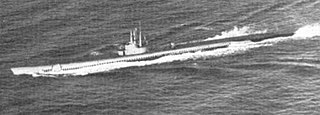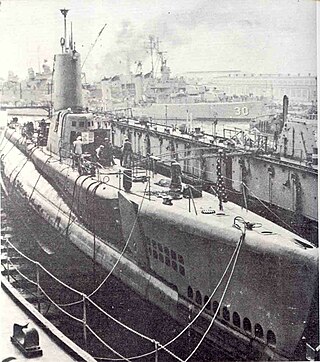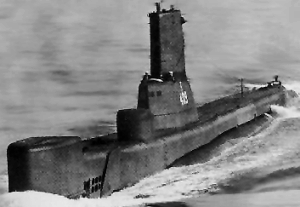
USS Amberjack (SS-522), a Tench-class submarine, was the second submarine of the United States Navy named for the amberjack, a vigorous sport fish found in the western Atlantic from New England to Brazil.

USS Runner (SS/AGSS-476), a Tench-class submarine, was the second ship of the United States Navy to be named for the runner, an amberfish inhabiting subtropical waters.

USS Tullibee (SSN-597), a unique submarine, was the second ship of the United States Navy to be named for the tullibee, any of several whitefishes of central and northern North America.

USS Volador (SS-490), a Tench-class submarine, was the second ship of the United States Navy to be named for the volador.

USS Pickerel (SS-524), a Tench-class submarine, was the second ship of the United States Navy to be named for a young or small pike.

USS Atule (SS/AGSS-403), a Balao-class submarine, was the only ship of the United States Navy to be named for the atule.

USS Remora (SS-487), a Tench-class submarine, was the only ship of the United States Navy to be named for the remora, a fish with a suctorial disk on its head enabling it to cling to other fish and to ships.

USS Sea Leopard (SS-483), a Tench-class submarine, was the only ship of the United States Navy to be named for the leopard seal. Her keel was laid down by the Portsmouth Navy Yard on 7 November 1944. She was launched on 2 March 1945 sponsored by Hon. Margaret Chase Smith, United States Congresswoman from Maine, and commissioned on 11 June 1945.

USS Medregal (SS-480/AGSS-480), a Tench-class submarine, was the only ship of the United States Navy to be named for the medregal, a streamlined, fast-swimming, bluish-colored fish of the jack family which abounds in waters of the West Indies and in the Atlantic as far north as the Carolinas.

USS Tusk (SS-426), a Balao-class submarine, was the only ship of the United States Navy to be named for the tusk, an alternate name for the cusk, a large edible saltwater fish related to the cod. Her keel was laid down on 23 August 1943 at Philadelphia by the Cramp Shipbuilding Company. She was launched on 8 July 1945 sponsored by Mrs. Carolyn Park Mills, and commissioned on 11 April 1946.

USS Trumpetfish (SS-425), a Balao-class submarine, was the only ship of the United States Navy to be named for trumpetfish, any of several fishes so-called for their deep, compressed body and long, tubular snout. Her keel was laid down on 23 August 1943 at Philadelphia by the Cramp Shipbuilding Company. She was launched on 13 May 1945 sponsored by Mrs. Oswald S. Colclough, and commissioned on 29 January 1946.

USS Quillback (SS-424), a Tench-class submarine, was the only ship of the United States Navy to be named for quillback, a fish of the sucker family, widespread in the freshwaters of North America and Northern Asia.

USS Chivo (SS-341), a Balao-class submarine, was a ship of the United States Navy named for the "chivo" or big-scaled goatfish Pseudopenaeus grandisquamis, a fish inhabiting the Pacific Ocean between Panama and Mexico.

USS Halfbeak (SS-352), a Balao-class submarine, was a ship of the United States Navy named for the halfbeak.

USS Sea Owl (SS/AGSS-405), a Balao-class submarine, was a ship of the United States Navy named for the sea owl, a lumpfish of the North Atlantic Ocean.

USS Sennet (SS-408) was a Balao-class submarine, a ship of the United States Navy named for the sennet, a barracuda.

USS Piper (SS/AGSS-409), a Balao-class submarine, was a ship of the United States Navy named after the piper. Although built late in World War II, Piper completed three successful war patrols before the cessation of hostilities, operating as a life guard for plane strikes and as an advance picket for fast carrier task forces.

USS Ronquil (SS-396), a Balao-class submarine, was the only ship of the United States Navy named after the ronquil, a spiny-finned fish found along the northwest coast of North America. It has a single dorsal fin and a large mouth and resembles the tropical jawfish.

USS Tiru (SS-416), a Balao-class submarine, was a vessel of the United States Navy named for the tiru, a member of the lizardfish family.

USS Johnston (DD-821) was a Gearing-class destroyer of the United States Navy, the second Navy ship named for Lieutenant John V. Johnston, who served in the Navy during the American Civil War.





















